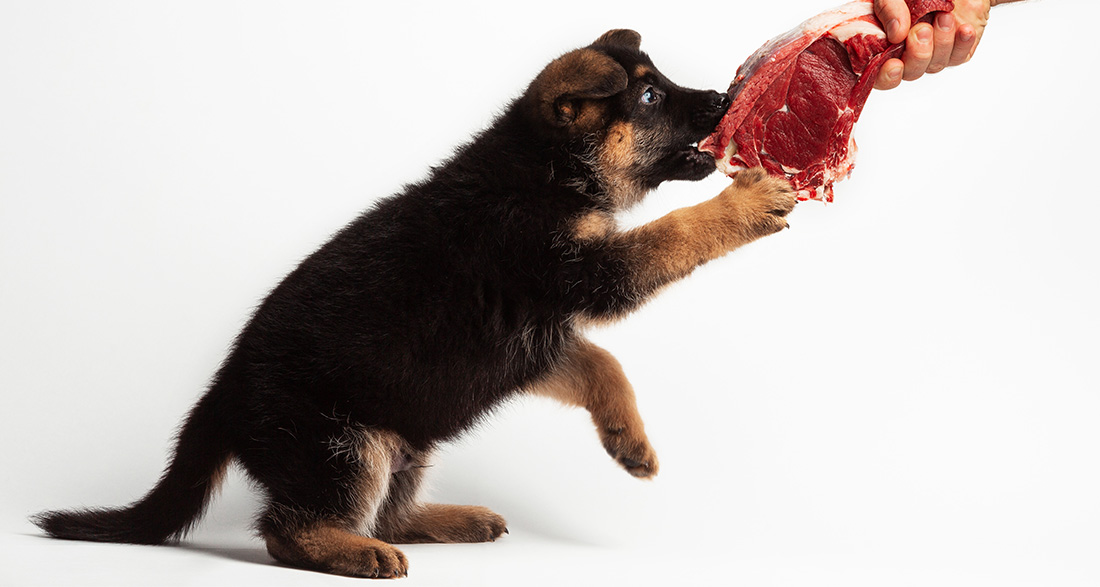In recent years, the practice of “Barfing” has convinced many animal lovers. However, there are several points to consider when using this feeding method, especially when it comes to barfing a puppy. We provide you with some initial guidance.
- Does it make sense to barf a puppy?
- Is barfing good for puppies?
- What should I consider when barfing a puppy?
- When can I start barfing a puppy?
- How do I start barfing?
- How much barf should a puppy get?
- How do I barf a puppy correctly?
- Barfing assistance from specialty stores
- Compromises and alternatives to a pure barf ration
Does it make sense to barf a puppy?
It is entirely possible and beneficial to barf a puppy. Barfing allows you to tailor the diet to your puppy’s specific needs. Additionally, you have the flexibility to choose the ingredients you prefer, determining the source and production methods of the food components.
Is barfing good for puppies?
Puppies can grow healthily and meet their nutritional needs with barf diets. However, it’s crucial to consider a balanced diet with all the necessary minerals, vitamins, and trace elements.
What should I consider when barfing a puppy?
While an adult dog already has specific nutritional requirements, a puppy with its rapid growth in a short period has a significantly higher demand for these nutrients.
The energy intake should not be too high to prevent excessive growth. At the same time, the calorie intake must be sufficient. The ration must also contain calcium and phosphorus in a balanced and adequate amount.
To find the right balance for appropriate feeding, you need extensive knowledge of nutrition. Therefore, it’s advisable to delve into pet nutrition. If you lack the time or want to ensure that you are feeding your puppy a healthy diet, seeking assistance from a nutrition consultant is beneficial.
When can I start barfing a puppy?
A puppy born in your home can receive easily digestible barf meals from the age of five weeks, in addition to mother’s milk. Include vegetables and ground raw bones alongside the meat to ensure calcium supply.
Around the seventh week, weaning from the mother begins. At this point, you can exclusively provide the offspring with barf nutrition.
The puppy can now also nibble on raw meaty bones, which supports dental care for the fresh milk teeth. To reduce the risk of injuries to the milk teeth, feed softer bones with plenty of muscles, such as chicken necks, lamb ribs, or ox tails.
How do I start barfing?

The simplest way is if the puppy has already been barfed by the breeder. In that case, you can continue with this familiar feeding routine.
If not, play it safe after your puppy arrives. During the first two weeks, continue feeding it with the familiar food. The transition to new food should always be cautious and gradual after the excitement of moving to a new home.
The right transition to barf rations For a transition from commercial dog food to a barf diet, continue primarily with the familiar food and gradually replace it with raw meat and vegetables. It’s crucial to make the transition slowly to allow the digestive system to adapt to the new diet.
Some puppies might be initially skeptical about the new food. To ease the introduction, you can feed the meat briefly cooked and gradually reduce the cooking time. Additionally, feeding a piece of meat as a treat by hand can stimulate the puppy’s appetite.
How much barf should a puppy get?
Whether commercial food or barf rations, a puppy should receive three to four portions per day. As a general rule regarding the quantity: A puppy needs four to six percent of its body weight daily.
For very small or very large breeds, the percentage must be adjusted upwards (very small) or downwards (very large). Individual needs must be considered, and the calorie intake calculated accordingly.
How do I barf a puppy correctly?
A typical barf ration is 80 percent animal-based and 20 percent plant-based. If feeding grains, these proportions need adjustments. A healthy dog without issues usually tolerates processed grains and other carbohydrates very well.
For a balanced diet with all nutrients, a ration must include the following components:
- Meat and animal products: Meat and other animal products serve as an energy source and a protein and amino acid source necessary for a puppy’s healthy growth.
- Vegetables and fruits: Vegetables and fruits are essential sources of fiber for the intestines. You can use fresh or dried flakes of vegetables and fruits. Please only feed foods suitable for dogs.
- Grains and others: Carbohydrates are not necessarily included in a classic barf ration for dogs. However, they provide quickly available energy for almost all metabolic processes in the body.
- Oils: Oils contain essential fatty acids. Since the levels of omega-3, omega-6 fatty acids, and vitamin E differ in oils, it’s advisable to add a mixture of different oils to the food.
- Supplements: A strict barf diet may not include artificial additives. In such a diet, all necessary minerals, trace elements, and vitamins are added through various natural components. You can use various processed grains, potatoes, or rice. Carbohydrate sources must be fed in a cooked form for optimal digestion. However, supplements tailored to the needs of a puppy and its food ration are easier to dose and provide better assurance.
Barfing assistance from specialty stores
For those who want a straightforward barfing experience, complete barf menus from specialty stores are now available. These menus consist of fresh meat and an optimally balanced portion of vegetables and fruits. However, they are not without challenges.
Not every menu always contains all the required nutrients. Pay particular attention to menus suitable for puppies, which list all essential nutrients in the ingredient declaration.
If you want to be sure, have a nutrition consultant review the feeding of a complete menu.
Compromises and alternatives to a pure barf ration
Barfing a puppy comes with risks as raw meat poses a significant risk of infection from various germs. This risk extends not only to the dog but also directly or indirectly to the owner, with young children and immunocompromised individuals being particularly vulnerable.
Home-cooked food Therefore, a compromise to barfing is feeding cooked rations. The loss of nutritional value in the meat is minimal, and the transmission of germs is prevented. The cooked portions are assembled in the same way as barf rations.
Partial barfing Partial or occasional barfing while simultaneously feeding commercial food is also possible. Just ensure that your puppy does not experience over or under-nourishment with all the necessary nutrients.
In any feeding method, the most crucial aspect is that your puppy tolerates it and can grow up healthy. In that case, you’ve done everything right.


